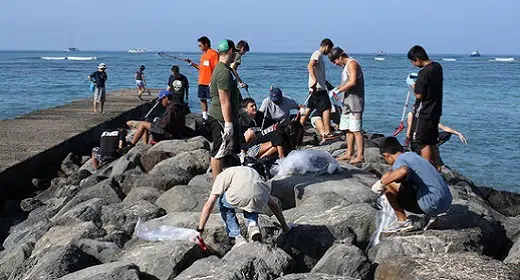by Ted Flanigan: Fifty-one years is a long time—a good run. Certainly not a momentous year, or milestone…
That was last year. But this year I launched The NetPositive Podcast and for our podcast’s first Earth Day, we feature an interview with Denis Hayes. He was the national coordinator of the first Earth Day in 1970, and founder of the Earth Day Network. He is credited with creating the largest secular movement in the world.
By 1990, Earth Day was “mobilizing” 200 million people in 190 countries. By now, and in collaboration with 75,000 partner organizations, Earth Day has mobilized a billion people worldwide.
The Early Days of Earth Day
Denis is warm and thoughtful, well past his activist days but with convictions that haven’t changed a bit. He puts fledgling Earth Day in perspective, juxtaposing environmentalism with the Nixon administration, the Vietnam War, Cambodia, and Kent State. There was decency in Congress then. Members could and did come together to address air pollution — smog — and water pollution, the worst of which made so stark by the Santa Barbara oil spill.
I remember Earth Day in 1970, the roadside clean-up organized by East Woods School. This was the first Earth Day, announced in a full-page New York Times advertisement. Our gang pulled a ridiculous amount of trash out of the bushes along Yellowcote Road. People had thrown their bottles roadside for years. Some disposal system. Earth Day was about changing behavior, for me recycling. It was about demanding an end to rampant air pollution. It was about cleaning the water. Rachael Carson’s Silent Spring had shocked us all. Imagine a spring with no birds chirping gaily… long gone due to chemicals and toxins spewed into the environment by industry. This was the time of Love Canal, a tearful native American in a canoe… an awakening of American eco-consciousness.
President Nixon saw Mayor John Lindsay in New York attracting huge crowds on Earth Day and was simply jealous. He soon thereafter formed the Environmental Protection Agency (EPA) to shine the light in his direction. Shortly thereafter, the Clean Air Act, the Endangered Species Act, the Clean Water Act were signed into law. Many of us see the role that Earth Day played in forging a broad environmental coalition.
The Earth Day Network went after “the dirty dozen,” 12 members of Congress with particularly bad environmental voting records who were up for reelection. Because of the spotlight shined on their environmental records, seven of the 12 were defeated, and the political power of the environmental movement was proven.
Backing up a bit, it was Senator Gaylord Nelson, a junior senator from Wisconsin, who first envisioned “Environmental Teach-Ins” at universities across the country. Nelson recruited Denis — took him away from the Kennedy School of Government at Harvard — and made him the national coordinator. The idea of “Environmental Teach-Ins” morphed into “Environmental Rights Day,” and ultimately “Earth Day.” Some five months later, 20 million people took to the streets.
According to Denis, there was a rare political alignment, Democrats and Republicans, rich and poor, could agree that we only have one planet and that we’d better take care of it. The Earth Day movement was about taking all these threads, weaving them together, and forming a nationwide rally. Walter Cronkite called it a “nationwide outpouring of mankind.” We were saving life from fouled skies and waters.
Earth Day held major events in 1970, 1990, 2000, 2010, and 2020. As the Energy Program Director at Rocky Mountain Institute, I spoke at Earth Day 1990 in Lincoln Park, Chicago. There were 100,000 people in the park, 20,000 in the stage area. I took the stage after Mayor Daily and Senator Paul Simon. “No, Chicago does not need nuclear […] that’s dangerous and costly. Instead, Chicago needs energy efficiency, it’s safe and inexpensive […]” I said with a compact fluorescent lightbulb held high to a thunderous applause. Those were the days.
Leading the Renewable Energy Movement
The podcast features Denis’s story at the head of the Solar Energy Research Institute, later renamed the National Renewable Energy Laboratory (NREL) in Golden, Colorado. Denis was appointed by President Jimmy Carter with a mission to chart a pathway to get 20% of all energy use in America from renewables by the year 2000.
Denis brought the best minds in from around the country to develop a renewable energy roadmap. But when Reagan took the presidency, in came the “dull grey men, in dull grey suits, walking dull grey hallways, thinking dull grey thoughts.” Quickly, Hayes finalized the research and shared it widely. U.S. Representative Richard Ottinger read the report into the public record. There was a new vision and roadmap, substantiating the claims and visions made by Amory Lovins and others. Later Brickhouse Publishing released the report as The New Prosperity. I have a copy in my library.
Bullitt Foundation Continues its Mission
Denis is a class act and a friend that I have known since 1986. After a distinguished career in both academics and activism, he’s been at the helm of the Bullitt Foundation, a foundation that has had the mission of making the Northwest region exemplary in terms of sustainability. Today, Bullitt is even more laser-focused geographically, specifically supporting sustainability in a region west of the Cascades, from Portland to Vancouver, the so-called “Emerald Corridor.”
Bullitt’s headquarters in Seattle features a solar mortar-board solar array of note, and rainwater collection. It uses one-seventh the lighting energy stipulated in the building code. It makes a striking statement.
Denis has made a lifetime of striking statements. Check him out on The NetPositive Podcast on Spotify, Apple, and Google.





















































